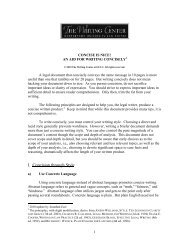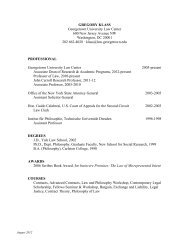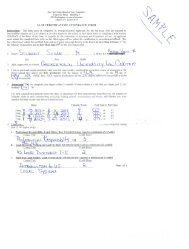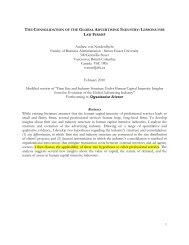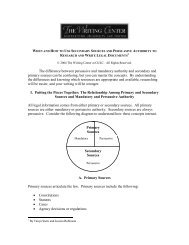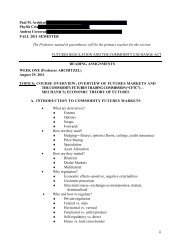Date: April 12, 2013 Topic: The Shrinking ... - Georgetown Law
Date: April 12, 2013 Topic: The Shrinking ... - Georgetown Law
Date: April 12, 2013 Topic: The Shrinking ... - Georgetown Law
You also want an ePaper? Increase the reach of your titles
YUMPU automatically turns print PDFs into web optimized ePapers that Google loves.
concentrated panel of law firms involved in relational governance. This mode involves less<br />
flexibility in terms of supplier selection but the firm benefits from reduced costs of<br />
contracting. For example, having an on-going and committed relationship with a law firm<br />
facilitates communication (as there is no need to identify points of contact or firm<br />
background), and ensures that the client firm will get the top partners for their case.<br />
We therefore expect a company’s willingness to invest in relational governance with a<br />
selected few law firms to result in a high degree of outsourcing and a smaller in-house legal<br />
department (Moeen et al., <strong>2013</strong>). By contrast, companies collaborating with a large number<br />
of law firms will increase their reliance on internal legal resources. Thus, we predict the<br />
following:<br />
H5: <strong>The</strong> larger the number of external law firms employed by a firm, the greater its<br />
reliance on the internal sourcing of legal services.<br />
EMPIRICAL METHODS<br />
Data and sampling<br />
To evaluate our theoretical framework and test our hypotheses, we first collect<br />
information on the size and composition of internal legal departments and their relationships<br />
with external law firms. This information is not publicly available, so we use proprietary<br />
survey and secondary data collected by ALM Legal Intelligence, a research unit within the<br />
American <strong>Law</strong>yer Media Group. ALM is a leading provider of news and information on legal<br />
markets, and offers detailed business information and competitive intelligence about the legal<br />
industry and their clients. In particular, we used ALM’s annual survey of in-house legal<br />
departments as well as ALM’s reports on corporate activity, including litigation, M&A<br />
transactions, and corporate bankruptcies. <strong>The</strong>se data are available from 2004 until 2011 for<br />
Fortune 500 companies 2 .<br />
2 For 2004 and 2005 the data are only available for Fortune 250 companies.<br />
16



